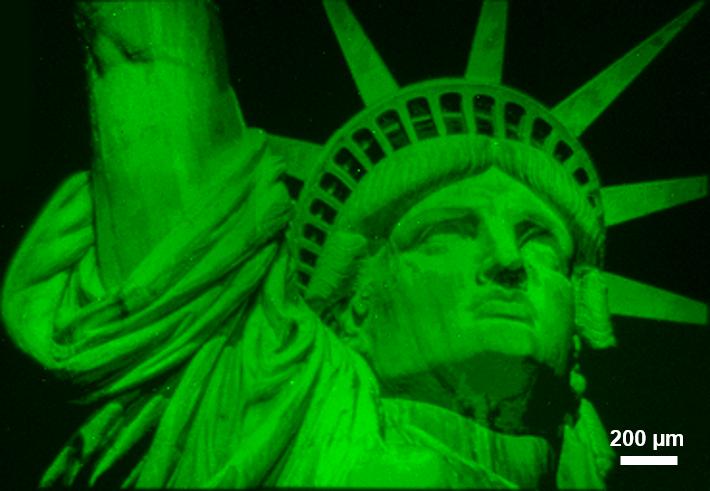The technology combines nanolithography, microfluidics, and organic chemistry to create synthetic surfaces at the scale and with the complexity of nature

Credit: Advanced Science Research Center
NEW YORK, March 6, 2020 — Researchers at the Advanced Science Research Center at The Graduate Center, CUNY (CUNY ASRC) and Northwestern University have created a 4D printer capable of constructing patterned surfaces that recreate the complexity of cell surfaces. The technology, detailed in a newly published paper in Nature Communications (DOI: 10.1038/s41467-020-14990-x), allows scientists to combine organic chemistry, surface science, and nanolithography to construct precisely designed nanopatterned surfaces that are decorated with delicate organic or biological molecules. The surfaces will have a wide variety of uses, including in drug research, biosensor development, and advanced optics. Importantly, this technology can create surfaces with different materials, and these materials can be patterned across the surface without the use of expensive photomasks or tedious clean room processes.
“I am often asked if I’ve used this instrument to print a specific chemical or prepare a particular system,” said the study’s primary investigator Adam Braunschweig, a faculty member with the CUNY ASRC Nanoscience Initiative and The Graduate Center and Hunter College Chemistry Departments. “My response is that we’ve created a new tool for performing organic chemistry on surfaces, and its usage and application are only limited by the imagination of the user and their knowledge of organic chemistry.”
The printing method, called Polymer Brush Hypersurface Photolithography, combines microfluidics, organic photochemistry, and advanced nanolithography to create a mask-free printer capable of preparing multiplexed arrays of delicate organic and biological matter. The novel system overcomes a number of limitations present in other biomaterial printing techniques, allowing researchers to create 4D objects with precisely structured matter and tailored chemical composition at each voxel–a capability the authors refer to as “hypersurface lithography”.
“Researchers have been working toward using lithographic techniques to pattern surfaces with biomolecules, but to date we haven’t developed a system sophisticated enough to construct something as complicated as a cell surface,” said Daniel Valles, a Graduate Center, CUNY doctoral student in Braunschweig’s lab. “We envision using this system to assemble synthetic cells that allow researchers to replicate and understand the interactions that occur on living cells, which will lead to the rapid development of medicines and other bioinspired technologies.”
As proof-of-concept, the researchers printed polymer brush patterns using precise doses of light to control the polymer height at each pixel. As illustrated by the Lady Liberty image, coordination between the microfluidics and the light source control the chemical composition at each pixel.
“Polymer chemistry provides such a powerful set of tools, and innovations in polymer chemistry have been major drivers of technology throughout the last century,” said the paper’s co-author Nathan Gianneschi, who is the Jacob & Rosaline Cohn Professor of Chemistry, Materials Science & Engineering, and Biomedical Engineering at Northwestern University. “This work extends this innovation to the interfaces where arbitrary structures can be made in a highly controlled way, and in a way that allows us to characterize what we have made and to generalize it to other polymers.”
“This paper is a tour-de force demonstration of what can be done with massively parallel lithography tools,” said Chad Mirkin, George B. Rathmann, Professor of Chemistry and the director of the International Institute for Nanotechnology at Northwestern University’s Weinberg College of Arts and Sciences, who is not a coauthor of the study. “The co-authors have created a powerful set of capabilities that should be heavily utilized across the chemistry, material science, and biological communities.”
The researchers plan to continue development of this novel printing platform to increase system speed, reduce pixel dimensions, and develop new chemistries for increasing the scope of materials that can be patterned. Currently, they are using the patterns created by this platform to understand the subtle interactions that dictate recognition in biological systems.
###
This research was supported by funding from the National Science Foundation, the Department of Defense through a Multidisciplinary University Research Initiative, and the Air Force Office of Science Research.
About the Advanced Science Research Center
The Advanced Science Research Center (ASRC) at The Graduate Center, CUNY is a world-leading center of scientific excellence, which elevates scientific research and education at CUNY and beyond through initiatives in five distinctive, but broadly interconnected disciplines: nanoscience, photonics, neuroscience, structural biology, and environmental sciences. The ASRC promotes a collaborative, interdisciplinary research culture where renowned scientists advance their discoveries using state-of-the-art equipment and cutting-edge core facilities.
About The Graduate Center of The City University of New York
The Graduate Center, CUNY is a leader in public graduate education devoted to enhancing the public good through pioneering research, serious learning, and reasoned debate. The Graduate Center offers ambitious students more than 40 doctoral and master’s programs of the highest caliber, taught by top faculty from throughout CUNY — the nation’s largest public urban university. Through its nearly 40 centers, institutes, initiatives, and the Advanced Science Research Center, The Graduate Center influences public policy and discourse and shapes innovation. The Graduate Center’s extensive public programs make it a home for culture and conversation.
Media Contact
Shawn Rhea
[email protected]
212-817-7180
Related Journal Article
http://dx.




